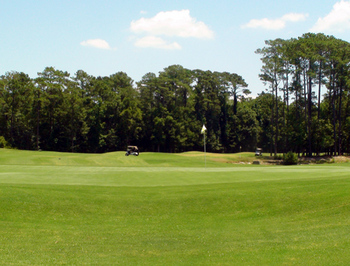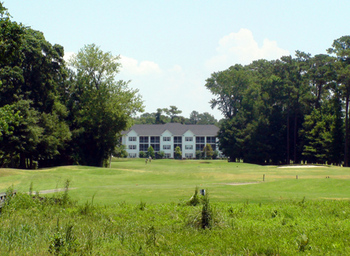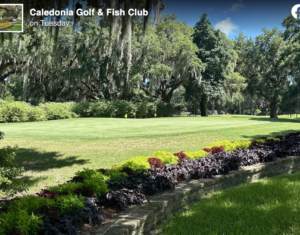Course Review: Wachesaw Is A Happy Hunting Ground For Golfers
Now, long after the television cameras have left, what remains is an outstanding golf course, one good enough to earn 4 stars in Golf Digest’s Best Places to Play Guide and Myrtle Beach Area Golf Course Owners Association Course of the Year honors. The course’s land is rich with history – it was home to a thriving rice plantation, too – and the course has added to it.
What can golfers expect to find at Wachesaw? The golf course is generally in outstanding shape and the champion Bermuda greens usually roll and between 9 and 9.5 on the stimpmeter, but the key to success is what happens before players get to the green.
Water and wetlands are a factor throughout the round, and every fairway is lined with trees. Mix-in rolling terrain and mounding that often frames the fairways, and a challenge awaits. But don’t be intimidated by Wachesaw’s visuals.
The tree-lined fairways are more generous, particularly in the landing areas, than they appear from the tee, and the forced carries aren’t typically onerous.
Wachesaw has tees as far back as 6,933 yards, but the vast majority of players will play from the blue (6,618 yards) or white (6,297 yards) tees, which offer enough length to allow for ample use of the driver but doesn’t necessitate its use.
 The flexibility the course offers players is important, because finding the fairways at Wachesaw is vital. The mounding along the fairways can funnel balls towards the short grass, but it also requires shots from uneven lies out of the rough.
The flexibility the course offers players is important, because finding the fairways at Wachesaw is vital. The mounding along the fairways can funnel balls towards the short grass, but it also requires shots from uneven lies out of the rough.
If you can put a driver in the fairway great, but if not, don’t be afraid to hit a 3-wood or even a hybrid off the tee. Because Wachesaw‘s greens are often elevated and well bunkered, having a good lie on the approach is essential. Players that miss greens will have difficulty getting up and down on a consistent basis.
Speaking of greens, Wachesaw’s are conducive to making putts. There is undulation in the greens, but it’s not extreme.
Four-time LPGA major winner Meg Mallon proved putts can be made at Wachesaw when she fired a course record 62 in 1998, but you don’t have to shoot 10 under par to enjoy the course.
The charm at Wachesaw doesn’t end on the 18th hole. The course has an outdoor bar and patio behind the clubhouse and it’s an ideal place to tally your scorecard and settle any outstanding bets.
Without further ado, here is a more detailed look at what you can expect to find on the course:
Par 3s
Wachesaw has a varied collection of par 3s, including the only two holes on the course where water doesn’t at least come into view.
The course’s shortest par 3 is also it’s first, the 165-yard, fourth hole. There is no water or wetlands to be found but the hole is nestled amongst trees. The prevailing wind is typically in your face but is sometimes hard to gauge because of the protection provided by the trees. Take one more club than you think you will need.
The eighth hole, known as Watery Grave, is one the course’s best. A lake runs from tee to green up the right side of the 180-yard hole and three bunkers loom as well. Don’t come up short.
The back nine par 3s are Wachesaw’s longest. The 185-yard, 12th hole brings wetlands and a waste bunker into play. The green is 37 yards deep so there is room to work with, but, like No. 8, coming up short isn’t an option playing from the blue (172 yards) or white (166 yards) tees.
The final par 3, the 15th is also the most challenging. The Oaks, as it’s known, plays 185 yards from the blue tees and 170 from the whites, requiring a mid to long iron. Players must play a left to right shot that allows them to navigate a pair of oak trees that come into play on the right side. If you overcut the tee shots, a large waste bunker awaits.
 Par 4s
Par 4s
Length is not the overwhelming concern on Wachesaw’s par 4s. Accuracy dictates success, though Johnston didn’t take the driver out of play. From the white tees, only one par four – No. 18 – plays more than 400 yards and just two others exceed 360 yards.
Long carries off the tee aren’t typical, but No. 2 is an exception. The dogleg right plays 385 yards from the blue tees and 375 from the whites, and the best tee shots find the left-center the fairway.
The sixth hole is the shortest par 4 (365 yards blue tees/342 whites) and its appropriately named “Narrow.” Players that can bomb the driver long and straight will have a short approach into a large green, but if you choose to layback off the tee, opportunity still awaits.
The most memorable front side par 4 is the ninth. Water runs from tee to green on the 420-yard hole and is complemented by a surplus of sand elsewhere. If you get a par here, you can rightfully head to the 10th tee with a smile on your face.
Memorable back nine par 4s include No. 14, which has an undulating, mounded fairway. Judging distance to the green is complicated by several mounds in front of the green, so make sure you check the yardage markers.
The closing hole is Wachesaw’s longest and toughest par 4. Two lakes loom on the left side of No. 18 and the green is surrounded by bunkers.
Par 5s
Wachesaw’s par 5s are an outstanding collection of holes, but don’t expect to take advantage of them. Three of the four par 5s play more than 500 yards from the blue tees, so only the longest of hitters can think of going for a green in two.
The front nine par 5s, in particular, require three good shots. The third hole (510 yards blue tees/495 white tees) requires a carry over wetlands off the tee and coming into the green. Stay on the left side of the fairway and play it smart.
The seventh hole is Wachesaw’s longest (550 blue/530 white) and one of its most challenging. A double dogleg, it’s a true three-shot hole.
The final two par 5s offer opportunity for gamblers, but there is risk. The 10th hole (515 blue/484 white) is straight as an arrow, and water isn’t a factor. Sand comes into play along the fairway, but take as much club as you can hit straight and pound away. With three good shots, the 10th offers the opportunity for birdie.
The 17th hole (485 blue/470 white) offers the classic risk-reward decision. It’s reachable for long hitters but a creek fronts a green that includes a false front, so you have to carry the ball to the middle of the green. It’s an outstanding hole.
The Verdict: Wachesaw burst onto the Myrtle Beach golf scene after hosting four LPGA Tournaments and has remained an area favorite. The layout is challenging, conditions are consistently good, and the customer service excellent.
Have you played Wachesaw Plantation East?



